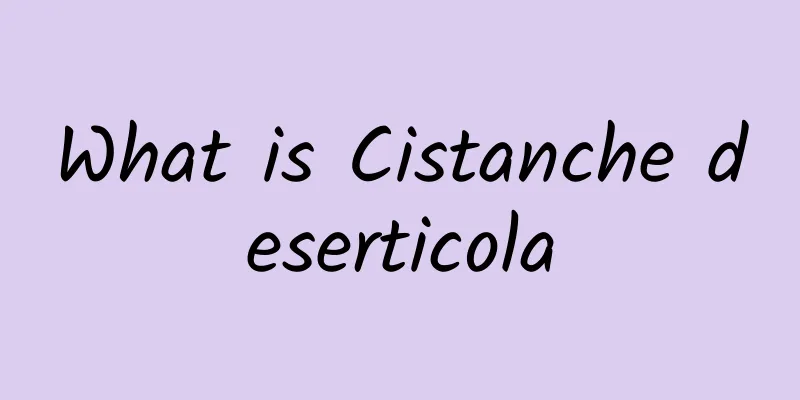What is Cistanche deserticola

|
Maybe you have never even heard of this name, Cistanche deserticola. Cistanche deserticola is a protected plant because it is an endangered plant. It does not require much water, so it can grow in some desert areas. Cistanche has extremely high medicinal value and is also a precious Chinese herbal medicine in China. Its main function is to nourish the kidney and strengthen yang. It has been mined and used since ancient times.
In addition to having some medicinal value, Cistanche deserticola, as a plant left over from the Mediterranean, plays a certain role in scientific research, which cannot be ignored. There are not many wild Cistanches left, and most of them are now cultivated artificially. Basic Information Chinese name: Cistanche deserticola also known as desert ginseng Chinese family name: Orobanchaceae Protection level: 3 [Alias] Dayun, Cunyun, Cistanche, Dijing, Chagan Gaoya (Mongolian). [Growth Habits] Cistanche deserticola is a parasitic plant that lives on the roots of the desert trees Haloxylon ammodendron and Tamarix chinensis. It has low requirements for soil and water and is a promising industry. Distributed in Inner Mongolia, Ningxia, Gansu and Xinjiang, it is known as the "Desert Ginseng" and has extremely high medicinal value. Cistanche is the fleshy stem of the Orobanchaceae plant Cistanche or Cistanche deserticola, Cistanche deserticola, etc. It has the effects of nourishing the kidney, replenishing essence, moistening dryness and lubricating the intestines. It is mainly used to treat male impotence, female infertility, leucorrhea, metrorrhagia, cold pain in the waist and knees, and constipation due to blood deficiency. [Origin and Output] The production is relatively high in the northwest of Xilinguole League, the north of Ulanqab League, the west of Ikh Ju League, Bayannur League, Alxa League, and Hexi region of Gansu. [Growth Habits] Cistanche deserticola is a parasitic plant that lives on the roots of the desert trees Haloxylon ammodendron and Tamarix chinensis. It has low requirements for soil and water and is a promising industry. Distributed in Inner Mongolia, Ningxia, Gansu and Xinjiang, it is known as the "desert ginseng" and has extremely high medicinal value. Cistanche deserticola is the fleshy stem of the Orobanchaceae plant Cistanche deserticola or Cistanche deserticola [1], Cistanche deserticola, etc. It has the effects of nourishing the kidney, replenishing essence, moistening dryness and lubricating the intestines. It is mainly used to treat male impotence, female infertility, leucorrhea, metrorrhagia, cold pain in the waist and knees, and constipation due to blood deficiency. [Medicinal part] The fleshy stem is used as medicine. [Collection and processing] Dig up in spring, remove the inflorescence, wash off the soil, dry in the sun, and slice for later use. [Nature, flavor and function] The traditional Chinese medicine tastes sweet and salty and is warm in nature. Nourishes the kidneys, strengthens yang, improves essence, and moistens the intestines. Functions and indications: Nourishes kidney yang, benefits essence and blood, moistens the intestines and promotes bowel movements. Used for impotence, infertility, soreness of waist and knees, weakness of muscles and bones, dry intestines and constipation. Mongolian medicine tastes sweet and salty and is warm in nature. It can calm "Xie Ri", help digestion and improve essence. [Main Indications] Traditional Chinese medicine is used to treat internal injuries due to deficiency and fatigue, cold pain in the waist and knees, impotence, spermatorrhea, infertility, and constipation due to physical weakness. Mongolian medicine is used to treat heartburn, stomach bloating, "Xie Ri" headache, impotence, spermatorrhea, premature ejaculation, leucorrhea, and pain in the waist and legs. [Dosage and Administration] 6-15 grams of Chinese medicine, decocted in water or made into pills or powder. The above introduces some knowledge about Cistanche in detail. I hope you can remember it in your mind after reading it. Because this Chinese herbal medicine is relatively precious, most people may not be able to use it, but knowing more about a Chinese herbal medicine can be helpful to you and broaden your understanding of this herbal medicine. |
<<: The role and efficacy of Gorgon Fruit
Recommend
Effects and functions of Ajuga
Ajuga is a medicinal herb that is quite common in...
What happens to people who wear headphones all year round? Do they really become deaf?
For many people, headphones must be an indispensa...
What are the medicinal values of shells?
I believe that when we were young, many of our fr...
Is it good to eat too much wolfberry?
There are many medicines in traditional Chinese m...
Staying up late during the holidays may feel good, but your organs are protesting! What is the ultimate truth about the life-saving sleep plan for "night owls"?
During such a lively time as the Spring Festival,...
The efficacy and function of Jigong Chaiguo
Jigongchai fruit is usually used as a medicinal m...
What are the methods of using the scraping board?
Everyone knows about scraping, which is a very tr...
"Prince Diary" - School is back! What was written on the "leave note" over 3,000 years ago?
At the beginning of September, the autumn breeze ...
"Iron Lung Man": Living in an Iron Can, Power Outage Means Death
Imagine that you are lying in a "tin coffin&...
Can Chinese medicine really treat high blood pressure?
Hypertension is a disease that modern humans are ...
What will humans wear when they arrive on Mars?
For a long time, humans have been full of curiosi...
Microplastics found in human blood for the first time, may have spread all over the body! These are possible sources...
Expert: Yu Xiaoxuan, PhD student, School of Envir...
Controlled nuclear fusion energy: How far is humanity from achieving energy freedom?
On the afternoon of August 25, China National Nuc...
The efficacy and function of Amomum villosum
Amomum villosum is very common in our lives, and ...
The efficacy and function of throat cooling tea
In daily life, people are not only very familiar ...









